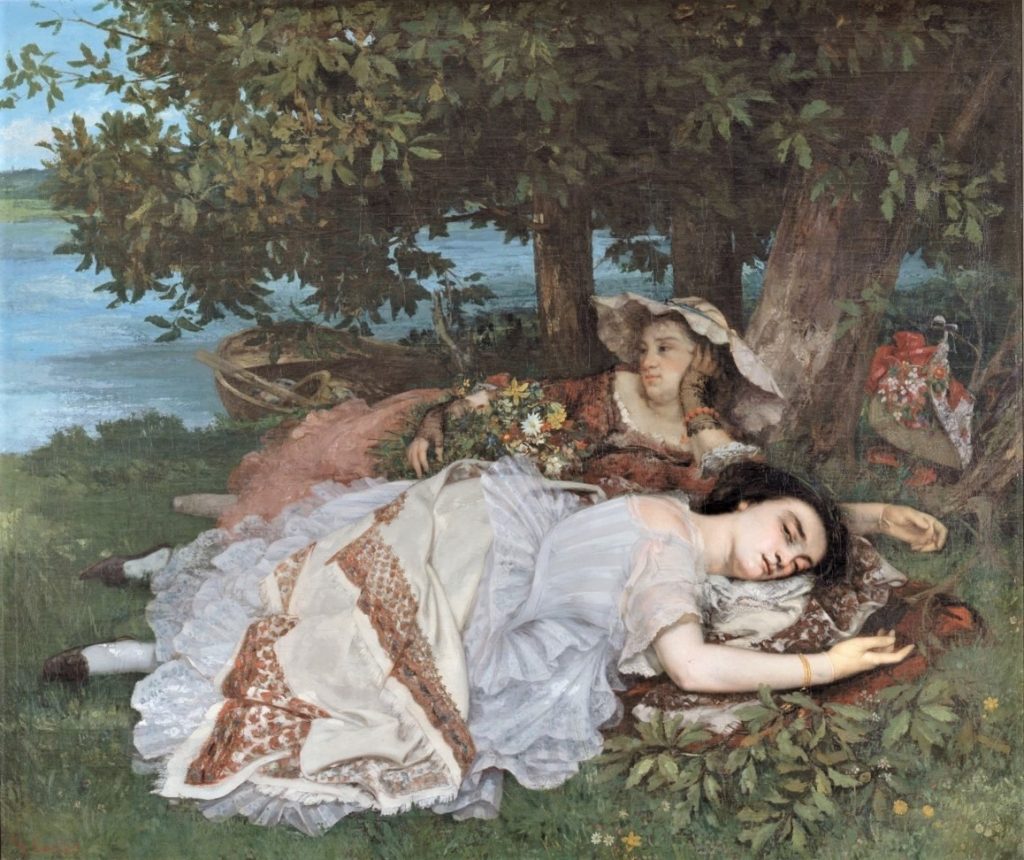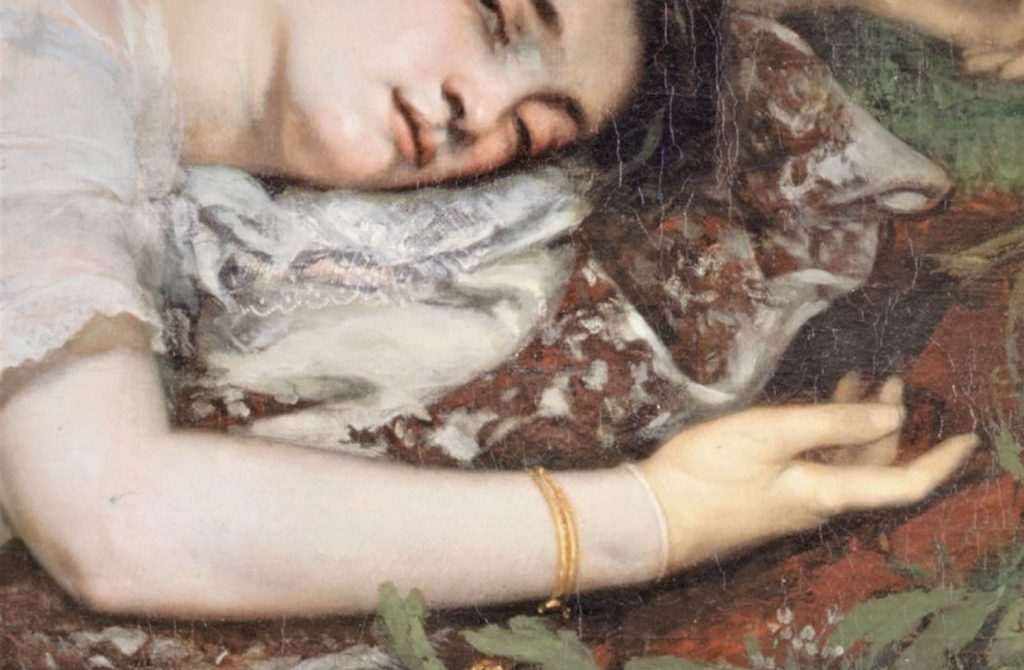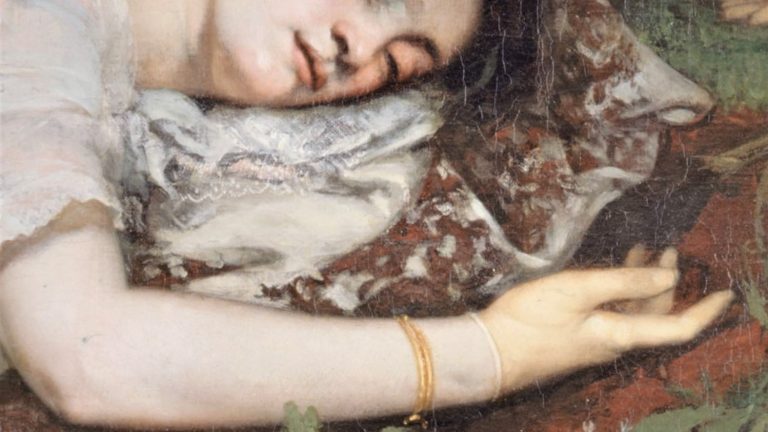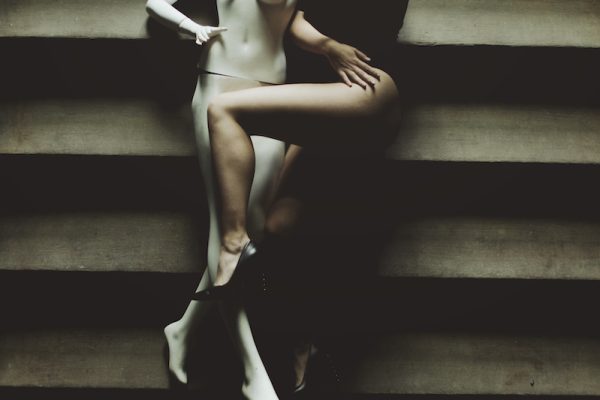The way we look at and interpret a work of art, and how we measure its scandalous character, remains influenced by the morality of the times in which we live in. However, morality is neither fixed once and for all, nor universal; it evolves according to the times and latitudes in which we find ourselves. That is why, since the Renaissance, many Western intellectuals have campaigned for art to be autonomous, so that artists have to be responsible only for their works on an aesthetic level and not on a moral level. Théophile Gautier theorized this concept we may call “autonomy of art” in the famous and courageous preface to his novel Mademoiselle de Maupin (1835). Charles Baudelaire and Gustave Flaubert also shared this theory which, even today, remains a subject of controversy. A major painting by Gustave Courbet called Les Demoiselles des bords de la Seine – été, (painted in 1857 and currently hangs in the Musée du Petit Palais in Paris) allows us to illustrate this point. When we look at this great canvas with our twenty-first century spectator eyes, what do we see?

It is a “partie de campagne”, as the Impressionists would paint thirty years later or that Guy de Maupassant would describe in his novels. On a hot summer afternoon, two women lie on the grass on the shores of the Seine River, in the shade of some oaks,. In the foreground, you can see a brunette dressed in white, lying on her chest, a shawl covers her lower back and legs. The yellow gloves on her hands are divinely painted in transparency by Courbet (fig. 1). She looks at the spectator – six years before Manet’s Olympia would do – with her eyes half-closed. Her flowery hat lies at the foot of a tree. In the background, her blonde friend wears a red dress, black lace mittens, and a wide hat. Lying against a tree trunk she supports her head with her left hand and holds a large bouquet of flowers against her body with her right hand. Her gaze, inexpressive, seems to be lost in the vagueness. Behind her, a boat, which they use to come to this peaceful place, is moored to the shore.

No one today is shocked by this scene, which seems trivial, or even anecdotal to us. However, when Courbet exhibited it at the Salon in1857, the painting aroused a resounding scandal among the public and critics. His radical realism made even Champfleury, who was the theoretician of realism and an admirer of Courbet, uncomfortable. To understand it, we must try to look at the work with the eyes of a visitor of the time. This one did not see two women but two prostitutes. Honest, bourgeois women would have been represented standing or sitting but never lying on the grass. In the mid-nineteenth century they were called”lorettes”, in reference to the Parisian district Notre-Dame de Lorette where many of them used to live. They occupied, in the hierarchy of prostitution, an intermediate place between the “pierreuses” (miserable street prostitutes) and courtesans (“Grandes Horizontales”). Coming from modest social backgrounds, the “lorettes” often worked as linens, seamstresses, ironers, etc. They also sometimes posed for painters and secured additional income by selling their charms. Other details, painted by Courbet, betrayed their status as urban prostitutes: the blonde’s colorful dress, her orange pearl bracelet too showy, her incongruous mittens for a Sunday in the country, her face made up without finesse or distinction. The brunette shocked even more because if today we see her dressed, everyone, at the time noticed that she wore only underwear (corset and petticoat) and that her dress, hastily removed (just like her hat thrown at the foot of the tree), served as a pillow. The painter, by representing two women lying side by side, maintained an ambiguity about their relationship. In this puritan era when Sapphism was a great taboo, and therefore a great fantasy of men, the archetypal lesbian couple always consisted of a blonde and a brunette –with the brunette playing the virile role. We find a confirmation of this cliché in George Sand’s novel Lélia, and in Baudelaire’s poem Delphine et Hippolyte.

A painting of two supposed lesbian prostitutes, presented at the Salon in a large format (1.74 x 2.06 m), was enough to create a scandal. But Courbet added an additional detail that shocked the audience even more: in the boat moored on the shore, he placed a man’s hat, suggesting that a man was accompanying the two friends (fig.2). This clue accentuated the erotic tension of the canvas, multiplying the possibilities of erotic relations between the three characters. One wondered if the bouquet of flowers held by the blonde was not the proof of gratitude of a lover or a satisfied customer. Moreover, the visitor to the Salon could wonder about the identity of this man. Was he the painter, the lover of the blonde or the brunette, or of both, or their pimp? Or was he the spectator himself, who had become an unwitting actor in the scene? The press strongly protested against the painting, much Courbet’s delight, who had long used scandal as a promotional tool. The tone of the articles was decidedly moralistic. Eight years later, the philosopher Pierre-Joseph Proudhon still evoked these women as carriers of a “satanic seduction”, called them “vampires” and alerted the public: ” Run away if you value your freedom, your dignity as a man, if you do not want this Circe to make you a beast.” Pablo Picasso, for whom morality in art was nonsense, detected in this painting a major work of the nineteenth century. This fact remained scandalous in the eyes of his communist comrades,. He confided later to his lover Françoise Gilot that he saw in it the origin of modernity in painting and devoted to the canvas a masterful and very personal reinterpretation, Les Demoiselles des bords de la Seine, after Courbet (1950, Basel, Kunstmuseum).
Written By Thierry Savatier





